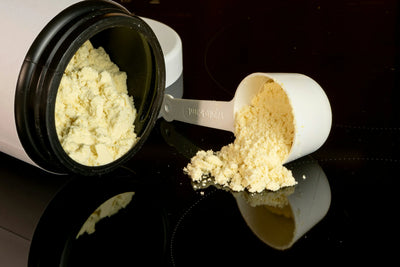Introduction
Dogs are indispensable companions in many homes, warming our lives with their loyalty and companionship. However, do you feel a twinge of concern when your fur child scratches incessantly, has reddened skin or emits a strange odor from the ears? These could be signs of dog allergies!
Allergies in Dogs Symptoms: How to Spot Red Flags (Itching, Rashes, Ear Issues)
Allergies are one of the most common health problems in dogs, but many owners know little about recognizing and responding to the symptoms. This article will take you in-depth understanding of the three common manifestations of allergies in dogs - itching, rashes and ear problems, to help you find the “red light” in time to protect the health and happiness of your dog.
1. Itching: the Unbearable “Torture” of the Fur Child
When you see your dog scratching frantically, even on the floor or sofa “rubbing around”, is not it both heartbreaking and helpless? Itching is the most intuitive “distress signal” of allergies in dogs. Allergies will make the dog's skin become extremely sensitive, as if countless insects crawling on the skin, forcing them to use their paws, teeth and even the body to desperately “relieve the itch”. This behavior not only makes the dog in pain, but also may scratch the skin, laying a hidden danger of infection.

The “culprits” that cause itching are many and varied. Environmental pollen, dust mites, grass seeds, and even household cleaners or herbicides can be allergens that can cause your dog's skin to “throw a tantrum”. In addition, food allergies are also common, such as wheat, corn or certain meat proteins can trigger the dog's immune system to “protest”, resulting in itching all over the body. Imagine, the dog just ate a bite of unsuitable food, have to endure this scratching pain, how can not let a person's heartache?
Owner's Tip: If your dog scratches incessantly, you may want to record its recent exposure to food or environmental changes, such as a new dog food or a park it has just visited. You can give your dog a bath with a mild pet-specific lotion to temporarily relieve the itching. However, if the symptoms persist and the skin is even red and swollen, take your dog to the veterinarian and find out what the allergens are.
2. The Rash: the Skin “Red Alert”
In addition to itching, rashes are also the “obvious bag” of dog allergies. When the allergen “invasion”, the dog's skin may appear red spots, pimples, and even blisters, looks like the skin in the “shouting”. These rashes are most likely to appear on the abdomen, armpits or inner limbs where the skin is delicate. Once the dog feels itchy, it will not be able to resist scratching and licking, which may make the rash worse, or even lead to infection, pustules or scabs, which will be more difficult to treat.
The appearance of the rash not only makes the dog difficult, but also makes the owner upset. Imagine the heartbreaking image of a fur child's otherwise smooth skin becoming red and blotchy, or even broken from scratching! Worse yet, if left untreated, rashes can lead to more complex skin problems and even affect your dog's mood and appetite.
Owner's Tip: The first step to stop your dog from scratching when you find a rash is to put an Elizabethan collar on him to protect his skin from further “damage”. Next, check your dog's living environment and clean up areas that may harbor allergens, such as pet mats or carpets. Minor rashes can be relieved with a pet care spray, but if the rash spreads, or if your dog develops a fever or is depressed, don't delay, go straight to the vet! They may use anti-allergy drugs or antibiotics to control the symptoms, and help you find the “culprit”.
3. Ear Problems: The “Invisible Crisis” Hidden in the Ears
The dog's ears are also the “hardest hit” area of allergies. When allergies strike, the dog's ears may be red, swollen, itchy, and even emit a foul odor. You may find your dog frequently shaking his head, scratching his ears, or even making low whining noises as if he's complaining about his discomfort. The “culprits” behind ear allergies may be environmental allergens such as pollen and dust, or they may be a projection of a systemic reaction in the ear triggered by a food allergy.
If left untreated, ear allergies can “escalate” into ear infections, even ear mites or otitis media. These problems can worsen your dog's pain and even affect his hearing and balance. Imagine your dog's sensitive ears becoming red and swollen, how can you not be anxious?
Owner's Tip: Check your dog's ears regularly for redness, swelling, discharge or odor. Minor symptoms can be carefully cleaned with a pet-specific ear cleaning solution to relieve itching. However, if the ear swelling is obvious or there is a purulent discharge, rush to take your dog to the veterinarian for a checkup. The vet may treat it with special medication and help you analyze the allergens and adjust your dog's diet or environment to prevent the problem before it occurs.
4. The Guardian of the Hair Child: the Master's Response to the Brocade Bag
In the face of dog allergies, the owner is not only a “detective”, but also a “guardian”. Here are some practical suggestions to help you hold a healthy umbrella for your dog:
(1) Daily prevention: prevention is better than cure
Keep the environment fresh: Regularly clean the kennel, toys and eating utensils to minimize the “hiding places” for dust mites and bacteria. Choose mild, non-irritating detergents to avoid chemical residues.
Scientific feeding: Choose hypoallergenic, high-quality dog food for your dog, and avoid foods that contain additives or potential allergens. If you suspect a food allergy, try the “elimination method”, gradually replacing ingredients to find the “problem food”.
Regular checkups: Even if your dog seems active, it's important to take it to the veterinarian every year for a “checkup”. Early detection of problems is the only way to prevent them.

Noora Allergy Support Health Supplement
(2) Symptoms: respond calmly
Isolation of allergens: When allergy symptoms are detected, recall your dog's recent “itinerary” or dietary changes, and identify and isolate suspected allergens as soon as possible. For example, the new dog food may be a “suspect”, so you can change back to the old food first and observe.
Localized care: Minor itching or rashes can be relieved with pet-specific lotions or sprays; ear problems can be cleaned with cleansing solutions. However, these are only “emergency” treatments and cannot replace professional treatment.
Seek medical attention: If symptoms are severe, such as a large rash, persistent scratching or ear infections, don't take it lying down! Your veterinarian will pinpoint the allergens through examination and develop a targeted treatment plan, such as anti-allergy medication or environmental adjustments, so that your dog can be free of pain as soon as possible.
Allergy problems in dogs are common, but as long as the owner observes carefully and responds in time, he or she can make the fur child suffer less. Every time we see our dogs scratching because of itching or shaking their heads because of ear discomfort, our hearts will also be torn up. I hope this article can help you become a more sensitive “dog health detective”, through scientific care and professional help, so that your fur child away from allergies, and always maintain the lively and happy!
Grass Allergy in Dogs: Identifying, Treating, and Preventing Seasonal Outdoor Triggers
With spring breezes and green grass, taking your dog outdoors to have fun is a happy time for many owners. However, that joy may turn to worry when you notice your furry child coming home with scratching, reddened skin, and even a foul odor coming from his ears. These symptoms may point to a common but easily overlooked problem - grass allergies. An “invisible enemy” of your dog's health, grass allergies can make your dog miserable. In this article, we'll take you through how to identify, treat and prevent grass allergies in dogs, so that your furry child can run carefree in the sun!
Recognizing Grass Allergies: Capturing Your Dog's “Mayday” Signals
Grass allergies are a common seasonal problem for dogs, especially in the spring and fall when pollen is high. Understanding the symptoms is the first step in helping your dog, and owners need to act as “health detectives” and carefully observe the following signals:
(1) Symptoms: “Allergy Alert” for Dogs
Itchy skin: The dog will scratch like crazy, especially on the paws, abdomen or groin, like fighting an invisible “little monster”.
Redness and rashes: Red spots or small pimples may appear on the skin, as if the skin is “protesting”.
Frequent licking: Your dog may lick his paws or body in an attempt to relieve discomfort, leaving his fur wet.
Ear problems: Ears are red, swollen, itchy, or even smelly, and the dog frequently shakes his head or scratches his ears as if he is saying “his ears hurt”.
Eye and nose problems: Tearful eyes, runny nose, even sneezing, like a “doggy version of the flu”.
Hair loss or skin damage: Excessive scratching can lead to hair loss or skin damage, and in severe cases, infection.
These symptoms are not only uncomfortable for the dog, but also heartbreaking for the owner. Imagine the original lively appearance of the fur child is replaced by itching and discomfort, how can not make people want to help it immediately “stop itching”?
(2) Allergens: the “invisible assassins” in the lawn
The main culprit of grass allergy is usually grass pollen. The pollen from the following common grasses is especially prone to “trouble”:
Bermuda grass: commonly used in lawns, seemingly harmless, but pollen is allergic to “big”.
Ryegrass: pollen allergic strong, the dog a “step” may be hit.
Fescue grass: some varieties of pollen can also make the dog's skin “temperament”.
These pollens enter the body through the dog's skin, respiratory tract and even licking, triggering an immune system “overreaction”. Understanding the source of allergens can help you protect your dog.
2. The Treatment of Grass Allergies: Let the Dog Back to Comfortable
Timely treatment is key after discovering your dog's grass allergy symptoms. Depending on the severity of the symptoms, owners can adopt different strategies to help their fur kids say goodbye to discomfort.
(1) Mild symptoms: gentle care to relieve discomfort
Gentle Cleaning: Bathing your dog with a pet-specific lotion containing oatmeal ingredients can effectively remove pollen from the skin and relieve itching. Gently massage your dog while bathing, like a “soothing SPA”.
Topical care: After each walk, wipe your dog's paws, belly and body with special antibacterial wipes to reduce pollen “sticking”. This is like removing makeup from your dog's skin to keep it fresh.
Antihistamines: Benadryl can relieve runny or sneezing skin, but has limited effect on itchy skin. Always consult your veterinarian to determine a safe dose before use.
Supplement with Omega fatty acids: Omega-3 and Omega-6 strengthen the skin barrier and reduce inflammation. Long-term supplementation is like putting a “protective coat” on your dog's skin.
(2) Severe symptoms: specialized treatment, precise response
When the symptoms worsen, such as large rashes or ear infections, owners need to take their dogs to the veterinarian for professional treatment:
Steroids: such as prednisone, can quickly “extinguish” severe itching, but long-term use may have side effects, and need to strictly follow the guidance of the veterinarian.
Immunomodulatory drugs: Injections such as Apoquel or Cytopoint are effective in controlling itching and giving your dog a “sigh of relief”.
Immunotherapy: After identifying specific allergens through skin or blood tests, your veterinarian may recommend immunotherapy to gradually “train” your dog's immune system to be more tolerant to pollen.
These treatments act as a customized “health prescription” for your dog, relieving symptoms and reducing the root cause of the allergy.

3. Preventing Grass Allergies: A “Protective Umbrella” for Dogs
Prevention is better than cure! Through the following methods, owners can minimize the dog's exposure to grass allergens, so that they are away from the pain of itching.
(1) Reduce exposure: Avoid the “allergy minefield”
Control outdoor time: In spring and fall when pollen is high, try to reduce the time your dog spends on the grass, especially in the early morning and evening when pollen concentration is high.
Clean in time: After each outdoor activity, scrub your dog's paws and body with wet wipes or water to remove any pollen that may have adhered to them, just like “washing away the day's fatigue” for your dog.
Mow your lawn: Keep your lawn short to minimize pollen production. A short lawn is not only refreshing, but also makes your dog feel more at ease.
(2) Environmental management: Creating a “hypoallergenic” living space
Cleaning: Vacuum regularly and wash your dog's mattress, toys and carpets to minimize pollen “hiding places” in the house.
Air purifier: Use an air purifier at home to reduce the concentration of pollen in the air and create a “fresh nest” for your dog.
(3) Dietary management: Strengthen resistance from the inside out
Nutritional supplementation: Add Omega-3 and Omega-6 fatty acids as recommended by your veterinarian to strengthen your dog's skin barrier, like adding a layer of “natural armor” to the skin.
Hypoallergenic diet: Reduce the likelihood of food allergies by choosing a quality dog food that is free of common allergens. A healthy diet is your dog's “inner strength” against allergies.
Grass allergies are common, but not invincible. As long as the owner carefully observes the symptoms, treats them in a timely manner, and reduces exposure to allergens through scientific prevention, the dog will be free from itching and discomfort, and will be able to regain the joy of playing in the grass. Regular communication with your veterinarian and a care plan that takes into account your dog's individual condition is the key to guarding your furry child's health. May every dog run free under the sun and enjoy a carefree good time!
Puppy Seasonal Allergies: Top Remedies for Pollen, Mold, and Environmental Triggers
Spring is here, the grass is growing, and it's a great time to take your pup outdoors for a romp. However, the joy may be replaced with worry when you notice that your little one is scratching, has teary eyes, and is even depressed. These symptoms may point to a common problem - seasonal allergies. Your puppy's immune system is not yet fully mature and is more susceptible to pollen, mold and other environmental “tricksters”. Don't worry! In this article, we'll take you into the world of seasonal allergies in puppies and show you how to recognize the symptoms, treat them, and prevent them so that your furry child can grow up healthy and happy!
Recognizing Allergy Signals: Listening to Your Puppy's “Silent Plea”
Seasonal allergies in puppies are often triggered by pollen, mold or environmental factors, and the symptoms are so varied that they can be overlooked if you're not paying attention. As owners, we need to be careful to catch the following “distress signals”:
Itchy and swollen skin: Your little one may scratch his paws, belly or ears like crazy, resulting in red spots and pimples on the skin, or even hair loss due to excessive scratching, which looks heartbreaking.
Ear problems: Ears are red, swollen and itchy, puppies may shake their heads or scratch their ears frequently, and in severe cases, they may emit an odor suggesting an ear infection.
Respiratory problems: sneezing, runny nose, and even shortness of breath, like a “doggy version of a cold”, which can lead to asthma in severe cases.
Eye discomfort: red, swollen, tearful eyes, increased secretion, like “silent crying”.
Mood and appetite changes: The discomfort of allergies may cause your puppy to lose its appetite, become lethargic or listless, as if its usual liveliness has been “stolen”.
These symptoms are not only difficult for the puppy, but also heartbreaking for the owner. Imagine a tiny ball of fur scratching incessantly because of the itchiness, how can you not want to help it “stop itching” immediately?
2. The Treatment of Allergies: Give Your Puppy the Most Attentive Care
After discovering your puppy's allergies, timely treatment is key. Depending on the severity of the symptoms, owners can take the following methods to help their little ones regain comfort.
(1) Medications: Putting out the fire with precision
Antihistamines, such as loratadine, can effectively relieve symptoms such as itching and sneezing, and act as a “pause button” for your puppy's allergic reaction. Consult your veterinarian for dosages to ensure safety.
Corticosteroids: such as dexamethasone, for severe allergies, can quickly control inflammation. However, long-term use may have side effects and should be used with caution under the guidance of a veterinarian.
Immunomodulatory medications: Injections such as Apoquel or Cytopoint can quickly relieve itching and give your puppy a “sigh of relief”.
Antibiotics and antifungal medications: If scratching leads to skin or ear infections, your veterinarian may prescribe antibiotics or antifungal medications to clear up secondary infections.
(2) Topical care: Gentle soothing of the skin
Gentle wash: Bathe your puppy with a pet-friendly lotion containing oatmeal to gently remove pollen and mold and relieve itching. Massage gently when bathing, like a “soothing SPA” for your little one.
Ear cleaning: Regularly clean out the ear canal with a pet-specific ear cleaning solution to remove secretions and allergens and keep the ears fresh.
Topical ointment: Antibacterial or antifungal ointment can be applied directly to rashes or redness to precisely repair damaged skin.

(3) Environmental control: Creating a “hypoallergenic” world
Reduce outdoor time: During the spring or wet season when pollen and mold are high, try to minimize the time your puppy spends on grass or in the woods, especially in the early morning and late afternoon when pollen levels are high.
Timely Cleaning: After each walk, wipe your puppy's paws, belly and body with a wet wipe or warm water to remove any attached allergens, just like “dusting off” your little one for the day.
Indoor management: Use an air purifier to filter out pollen and dust mites; vacuum regularly and clean your puppy's mattress and toys to create a “hypoallergenic nest”.
(4) Dietary management: Strengthen your puppy's body from the inside out
Omega-3 fatty acid supplementation: Fish oil or special supplements can strengthen your puppy's skin barrier and reduce inflammation, just like putting “protective armor” on the skin.
Hypoallergenic diet: Choose hydrolyzed proteins or hypoallergenic formulas to reduce the risk of food allergies and provide “healthy energy” for your puppy.
(5) Immunotherapy: Curing recurrent allergies
For recurring allergies, your veterinarian may recommend skin or blood tests to identify specific allergens and then immunotherapy. Gradually increasing allergen exposure trains your puppy's immune system to “take it easy” and radically reduces symptoms.
Allergy Prevention: A “Healthy Umbrella” for Puppies
Prevention is better than cure! Through the following methods, owners can minimize their puppies' exposure to allergens and keep them away from discomfort.
(1) Regular Health Checks: Prevention is better than cure
Even if your puppy looks healthy and active, it is important to take it to the veterinarian for regular checkups. Early detection of allergic tendencies is the only way to prevent them.
(2) Careful observation: Be your puppy's “health detective”
Pay close attention to your puppy's behavior and physical changes, such as increased scratching frequency, sneezing or watery eyes, which may be an “early warning” of allergies. Once abnormalities are detected, take timely measures.
(3) Strengthening the immune system: inside and out
Strengthen your puppy's immune system through a balanced diet, moderate exercise and vitamin supplements. A healthy body acts as a “firewall” to minimize the risk of allergies.
Seasonal allergies in puppies are common, but not invincible. With careful observation, scientific treatment and daily prevention to minimize allergen exposure, you can keep your little one away from itchiness and discomfort and regain his or her lively nature. Every time we see our puppies playing in the grass, but scratching because of allergies, our hearts will also be torn up. We hope that every owner can be a “health guardian” for their puppy and develop a personalized care plan under the guidance of their veterinarian, so that their furry child can grow up healthily in the change of seasons and enjoy the happy times of their childhood!





